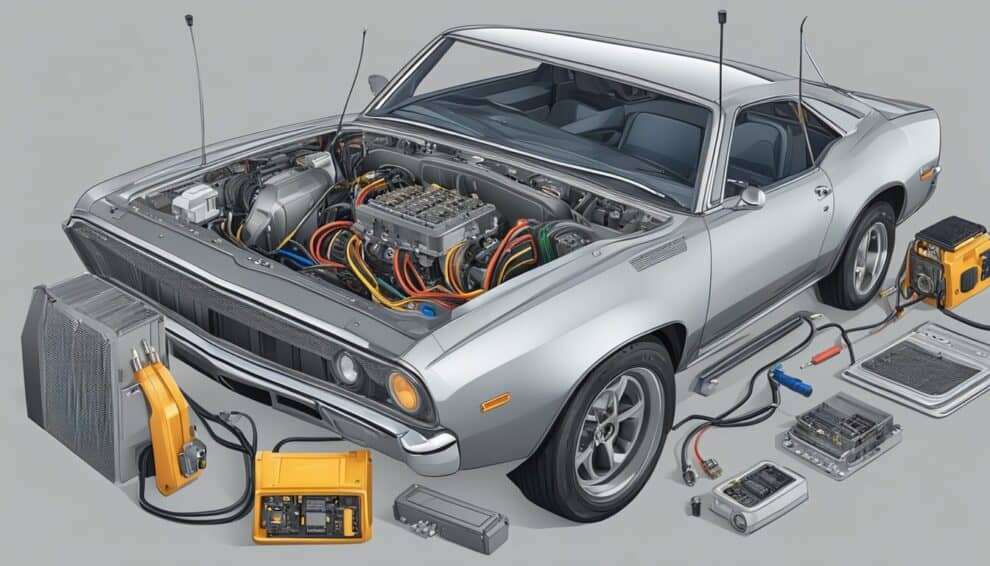If you own a vehicle, you may have heard about the alternator and its role in keeping your car’s battery charged.
However, you might not be familiar with the concept of alternator voltage regulation.
This is an important aspect of the alternator’s function that ensures the battery receives the correct amount of charge to keep your vehicle running smoothly.
Fundamentals of Alternator Voltage Regulation
Purpose of Voltage Regulation
The purpose of voltage regulation in an alternator is to maintain a steady output voltage, regardless of changes in the engine speed or electrical load.
This is important because the electrical systems in a vehicle require a specific voltage to operate correctly.
Without proper voltage regulation, the electrical components could be damaged or fail to function correctly.
Components of an Alternator
An alternator consists of several components that work together to produce electrical power.
These components include the rotor, stator, diode bridge, and voltage regulator.
The rotor is a rotating magnetic field that produces an AC voltage in the stator windings.
The stator is a stationary set of windings that convert the AC voltage to DC voltage through the use of a diode bridge.
The voltage regulator is responsible for controlling the output voltage by adjusting the current to the rotor.
The voltage regulator monitors the output voltage and adjusts the current to the rotor to maintain a steady output voltage.
The regulator achieves this by controlling the field current, which in turn controls the output voltage.
The voltage regulator is typically located inside the alternator and is either integrated into the alternator or mounted externally.
In summary, voltage regulation is a critical component of an alternator, ensuring that the electrical systems in a vehicle receive a steady voltage.
The components of an alternator work together to produce electrical power, with the voltage regulator controlling the output voltage by adjusting the current to the rotor.
How Voltage Regulation Works
The alternator voltage regulator is responsible for maintaining a consistent voltage output from the alternator.
This is important because the electrical systems in your vehicle rely on a consistent voltage to function properly.
Understanding how voltage regulation works is key to diagnosing and repairing any alternator issues.
Sensing and Sampling Voltage
The voltage regulator senses the voltage output of the alternator and samples it at regular intervals.
This is typically done by a small wire that connects to the alternator output terminal.
The voltage regulator then compares the sampled voltage to a reference voltage, which is typically set to around 14 volts.
Error Detection and Correction
If the sampled voltage is higher or lower than the reference voltage, the voltage regulator will adjust the field current to the alternator.
This is done by controlling the amount of current that flows through the alternator’s rotor, which in turn controls the output voltage.
The voltage regulator will continue to adjust the field current until the sampled voltage matches the reference voltage.
In order to ensure that the voltage regulation is accurate, the voltage regulator also performs error detection and correction.
This involves monitoring the voltage output and making small adjustments to the field current as needed to maintain a consistent voltage output.
Overall, the voltage regulation process is critical to ensuring that your vehicle’s electrical systems function properly.
By understanding how voltage regulation works, you can diagnose and repair any issues with your alternator and keep your vehicle running smoothly.
How Does Tesla Battery Technology Impact Alternator Voltage Regulation in Vehicles?
Tesla’s battery weight insights play a significant role in impacting alternator voltage regulation in vehicles. The cutting-edge technology of Tesla’s batteries has led to improvements in energy efficiency and power management, ultimately affecting the way alternators regulate voltage in modern vehicles.
Can Voltage Regulation Issues Cause a P0299 Code in a Vehicle’s Turbocharger System?
Voltage regulation issues can indeed cause a P0299 code in a vehicle’s turbocharger system. When the voltage is not properly regulated, it can lead to an inadequate power supply to the turbocharger, resulting in a turbocharger underboost condition. This can trigger the P0299 trouble code and cause performance issues.
Types of Voltage Regulators
Mechanical Voltage Regulators
Mechanical voltage regulators were used in older vehicles and were typically mounted on the alternator.
These regulators use a set of contact points and a spring-loaded arm to regulate the voltage output of the alternator.
As the voltage output increases, the arm moves and opens the contact points, which reduces the voltage output.
Conversely, when the voltage output decreases, the arm moves in the opposite direction and closes the contact points, which increases the voltage output.
Mechanical voltage regulators are simple and reliable, but they are not very precise and can wear out over time.
Electronic Voltage Regulators
Electronic voltage regulators are now commonly used in modern vehicles and are typically integrated into the engine control module (ECM).
These regulators use solid-state components, such as transistors and diodes, to regulate the voltage output of the alternator.
The ECM monitors the voltage output and adjusts the current flow through the alternator to maintain a consistent voltage output.
Electronic voltage regulators are more precise than mechanical regulators and can provide better control over the charging system.
They are also more durable and have a longer lifespan than mechanical regulators.
In summary, there are two main types of voltage regulators: mechanical and electronic.
Mechanical regulators are simple and reliable, but not very precise. Electronic regulators are more precise and durable, but more complex.
The type of regulator used in a vehicle depends on the age and model of the vehicle, as well as the manufacturer’s preferences.
How Does Voltage Regulation in an Alternator Affect Spark Plug Performance?
Voltage regulation in an alternator can directly affect the performance of spark plugs. If the voltage is too low, signs of worn spark plugs like misfiring and poor fuel efficiency may occur. Conversely, if the voltage is too high, it can cause accelerated wear on the spark plugs, leading to similar issues.
How Does Understanding Alternator Voltage Regulation Help Prevent Car Engine Overheating?
Understanding alternator voltage regulation is crucial for car engine heat issues prevention. Proper regulation ensures that the alternator produces the right amount of power to prevent electrical overloading and overheating. This helps maintain the overall health and performance of the engine, preventing costly repairs and breakdowns.
How Does Alternator Voltage Regulation Affect the Car Battery Cable Replacement Process?
When performing a stepbystep car battery cable replacement, it’s important to consider alternator voltage regulation. A faulty voltage regulator can cause the alternator to overcharge, leading to damage to the battery cables. Before replacing the cables, ensure the alternator is functioning properly to avoid future issues.
Wiring Diagrams and Installation
Reading Wiring Diagrams
Before starting the installation process, it is essential to understand the wiring diagrams.
The wiring diagram is a visual representation of the electrical circuit and shows how the components are connected.
It helps to identify the wires and their functions, making installation easier and more accurate.
Reading a wiring diagram can be overwhelming at first, but it is not as complicated as it seems.
The diagram consists of symbols that represent electrical components, such as resistors, capacitors, and switches.
Each symbol has a specific meaning, and it is essential to understand what each one represents.
To read the wiring diagram, start by identifying the power source and the ground.
Then, follow the wires to the components and identify their functions.
It is also essential to understand the color codes used in the diagram, as they indicate the wire’s function.
Step-by-Step Installation Guide
Now that you understand the wiring diagrams, it’s time to start the installation process.
Here is a step-by-step guide to help you install the alternator voltage regulator:
- Disconnect the battery to avoid electrical shock.
- Remove the old voltage regulator and disconnect the wires.
- Connect the wires from the new voltage regulator to the alternator and battery.
- Use a multimeter to check the voltage output and adjust the regulator if necessary.
- Reconnect the battery and start the engine to test the voltage output.
It is essential to follow the manufacturer’s instructions and use the correct tools and materials for the installation.
Always double-check the connections and ensure that everything is secure before starting the engine.
In conclusion, understanding the wiring diagrams and following the installation guide is crucial for a successful alternator voltage regulator installation.
With the right tools and knowledge, you can install the regulator and ensure that your vehicle’s electrical system is working correctly.
Troubleshooting Common Issues
Diagnosing Voltage Fluctuations
If you notice that your vehicle’s headlights are flickering or the battery is not charging properly, it could be due to voltage fluctuations.
The first step to diagnosing this issue is to check the alternator’s output voltage using a multimeter.
Connect the multimeter to the battery terminals while the engine is running and check the voltage reading.
A healthy alternator should produce a voltage output of around 13.8-14.5 volts.
If the voltage reading is lower than the recommended range, it could indicate a bad alternator or a loose alternator belt.
Check the belt tension and replace the alternator if necessary.
On the other hand, if the voltage reading is higher than the recommended range, it could indicate a faulty voltage regulator.
In this case, you will need to replace the voltage regulator to fix the issue.
Solving Regulator Failures
If your alternator is producing a voltage output that is too high or too low, it could be due to a faulty voltage regulator.
The voltage regulator is responsible for regulating the alternator’s output voltage to ensure that it stays within the recommended range.
To troubleshoot a faulty voltage regulator, you can perform a simple test using a multimeter.
Connect the multimeter to the battery terminals while the engine is running and check the voltage reading.
If the voltage reading is higher or lower than the recommended range, it could indicate a faulty voltage regulator.
Replacing the voltage regulator is the most effective solution to fix the issue.
However, before replacing the regulator, make sure to check the wiring connections and the alternator’s brushes.
Loose or corroded connections can also cause voltage fluctuations, so make sure to tighten or clean the connections if necessary.
As an Amazon Associate we earn from qualifying purchases.









